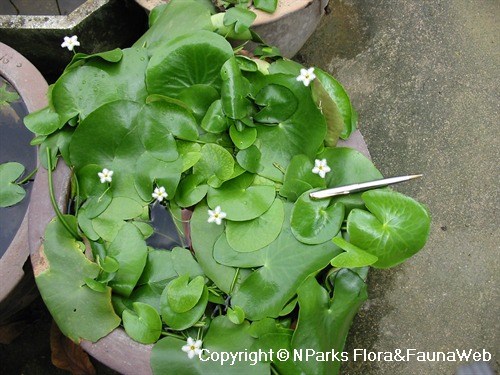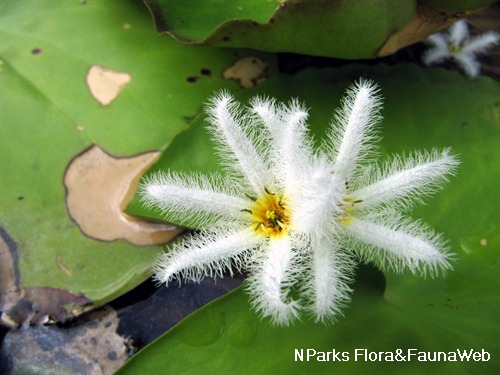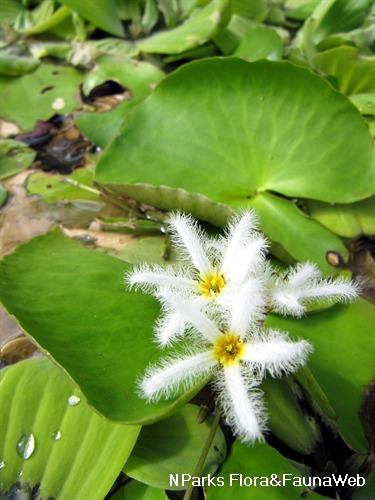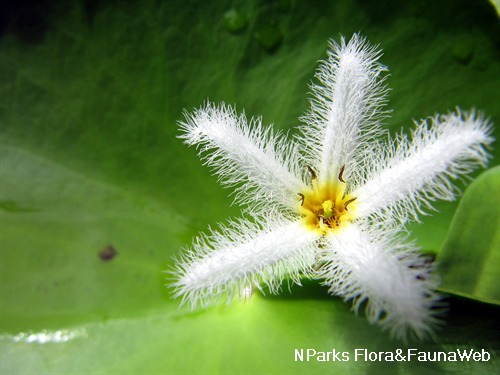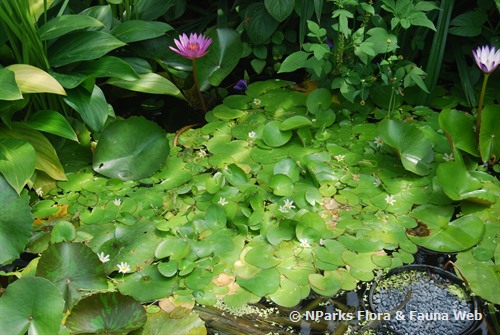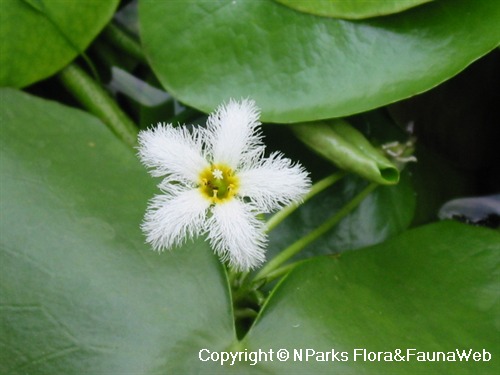
Back
Nymphoides indica (L.) Kuntze
| Family Name: | Menyanthaceae |
| Synonyms: | Limnanthemum indicum (L.) Griseb. |
| Common Name: | Water Snowflake, Fringed Waterlily, False Indian Waterlily, Water Gentian, 金银莲花 |
Nymphoides indica (Water Snowflake) is a perennial aquatic plant. Its rhizomes grow in the soil underwater and long thin stems support round-shaped leaves that float on the water's surface. Its delicate, white star-shaped flowers have a yellow centre and are fringed with frilly hairs making these blooms reminiscent of snowflakes. Although the flowers last only for a day, they are quickly replaced by new ones.
Name
Classifications and Characteristics
| Plant Division | Angiosperms (Flowering Seed Plants) |
|---|---|
| Plant Growth Form | Aquatic & Hydrophyte |
| Lifespan (in Singapore) | Perennial |
| Mode of Nutrition | Autotrophic |
| Plant Shape | Irregular |
| Maximum Height | 2 m |
Biogeography
| Native Distribution | Nepal, Sri Lanka, India, China, Cambodia, Myanmar, Vietnam, Peninsular Malaysia, Indonesia, Japan, Korea, Australia, and Pacific Islands |
|---|---|
| Native Habitat | Aquatic (Freshwater Pond / Lake / River) |
| Preferred Climate Zone | Tropical |
| Local Conservation Status | Cryptogenic |
Description and Ethnobotany
| Growth Form | It is a perennial, freshwater aquatic, non-woody plant consisting of a horizontally growing underground stem (rhizome) from which many elongated runners arise. Each runner is up to 2 m long, and consists of alternate, shortly-stalked leaves, and flower clusters. |
|---|---|
| Foliage | Its leaves have thickly fleshy leaf blades that float on water, are almost circular, 6–40 by 3–24 cm, with broad, heart-shaped bases, and smooth margins. |
| Flowers | Its stalked flowers are faintly fragrant, and found in clusters of up to 3, each above the water. Its yellow-centered flowers have spreading lobes that are covered with long, white hair above. |
| Fruit | Its fruits are ellipsoid, 6.8–8 by 3–5 mm, and contain many lens-shaped seeds. Its round seeds are smooth, pale brown and 1.3 mm wide. |
| Habitat | It grows in shallow, stagnant water, pools, flooded rice fields, and margins of lakes, up to 1900 m altitude. |
| Associated Fauna | Its flowers are insect-pollinated. |
| Cultivation | It can be propagated by seed, or by planting rooted shoots that develop near the insertion of the flowers at the tip of the flower-bearing stem. |
| Etymology | Latin Nymphoides, resembling Nymphaea (water lily) species; Latin indica, of India but also applies to plants originating throughout the East Indies, referring to one locality in the natural distribution of this species |
Landscaping Features
| Landscaping | It has attractive, large-, white- or yellow-flowered cultivars. It is a good native substitute for the non-native water-lily (Nymphaea species and hybrids). It may be suitable as a marsh plant for the edges or deeper parts of ponds. |
|---|---|
| Desirable Plant Features | Ornamental Flowers, Ornamental Foliage |
| Landscape Uses | Parks & Gardens, Small Gardens, Riverine, Pond / Lake / River, Marsh / Bog |
Fauna, Pollination and Dispersal
| Pollination Method(s) | Biotic (Fauna) |
|---|---|
| Seed or Spore Dispersal | Abiotic |
Plant Care and Propagation
| Light Preference | Full Sun |
|---|---|
| Water Preference | Lots of Water |
| Rootzone Tolerance | Waterlogged Soils (Does not Drain Site), Easy to Grow |
| Propagation Method | Seed, Division, Aerial Plantlet |
Foliar
| Foliage Retention | Evergreen |
|---|---|
| Mature Foliage Colour(s) | Green |
| Mature Foliage Texture(s) | Thick |
| Foliar Type | Simple / Unifoliate |
| Foliar Attachment to Stem | Petiolate |
| Foliar Shape(s) | Non-Palm Foliage (Obcordate) |
| Foliar Venation | Pinnate / Net |
| Foliar Margin | Entire |
Floral (Angiosperm)
| Flower & Plant Sexuality | Bisexual Flowers |
| Flower Colour(s) | White |
|---|---|
| Flower Grouping | Cluster / Inflorescence |
| Flower Symmetry | Radial |
Fruit, Seed and Spore
| Fruit Classification | Simple Fruit |
|---|---|
| Fruit Type | Dehiscent Dry Fruit , Capsule |
Image Repository
Others
| Master ID | 978 |
|---|---|
| Species ID | 2272 |
| Flora Disclaimer | The information in this website has been compiled from reliable sources, such as reference works on medicinal plants. It is not a substitute for medical advice or treatment and NParks does not purport to provide any medical advice. Readers should always consult his/her physician before using or consuming a plant for medicinal purposes. |


